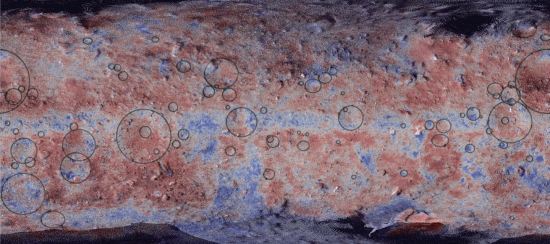The near-Earth asteroid Ryugu is only about a kilometer wide, but it’s telling us a good deal about its own history and that of the Solar System itself thanks to the two touchdowns of Hayabusa2, in February and July of 2019. The geological changes so clear on Earth, the bombardments from objects creating craters here and elsewhere, all mark the evolution of large bodies, but the asteroids take us back to the system’s earliest days with little change. They’re bundles out of the deep freeze of time.
Now we wait for the sample return, currently on its way back to Earth, with arrival in December of this year. Aboard will be surface materials collected during both touchdowns, which will complement the data on the chemical and physical composition of the asteroid already gathered. A team led by Tomokatsu Morota (University of Tokyo) has been using Hayabusa2’s onboard ONC-W1 and ONC-T imaging instruments to analyze the dusty matter kicked up by the spacecraft’s engines during the two touchdowns.
Fine grains of dark-red colored minerals turned up in this analysis. The team believes these were produced by solar heating, indicating close passage by the Sun at some point in Ryugu’s past. This view is reinforced by the distribution of the dark red-matter. Spectral examination shows the material can be found at specific latitudes on the asteroid, corresponding to areas that would have received the most solar radiation in the asteroid’s past. Adds Morota:
“From previous studies we know Ryugu is carbon-rich and contains hydrated minerals and organic molecules. We wanted to know how solar heating chemically changed these molecules. Our theories about solar heating could change what we know of orbital dynamics of asteroids in the solar system. This in turn alters our knowledge of broader solar system history, including factors that may have affected the early Earth.”

Image: False color map of the surface of Ryugu with craters marked by circles. Credit: © 2020 Morota et al.
The distribution of surface materials suggests a history of disruption by impacts and what the paper describes as thermal fatigue and mass wasting. Let me quote from this section:
The thickness of the mixed layer of redder and bluer materials is estimated to be a few meters, derived from the minimum crater size (~10 m in diameter) that penetrates to the underlying blue materials. The presence of ejecta rays with a length of a few tens of meters that consist primarily of redder materials implies that the redder material layer originally had a minimum thickness of a few tens of centimeters. Solar heating is more likely than space weathering to be the source of the reddening of Ryugu’s surface, because space weathering typically affects only a thin layer of ~100 nm, whereas the diurnal and annual thermal skin depths (the depth at which temperature variations decay to 1/e of their value at the surface) are ≲10 cm and ~1.5 m, respectively.
It’s encouraging to hear from Morota’s group that their spectral studies and examination of Ryugu’s albedo indicate that both the dark-red material once heated by the Sun as well as blue unheated materials would have been collected in Hayabusa2’s two forays to the surface. Also on the agenda in coming months is a close look at the distribution of Ryugu’s craters and boulders. The surface craters hold information about the characteristics of the asteroid’s rocks and the history of small impacts. They also greatly complicated the search for a safe landing site.
What produced the differences between the two types of materials remains unclear:
Two distinct types of material are present on the surface with different colors: bluer material distributed at the equatorial ridge and in the polar regions and redder material in the mid-latitude regions. However, the cause of these spectral variations is not understood.
The paper is Morota et al., “Sample collection from asteroid (162173) Ryugu by Hayabusa2: Implications for surface evolution,” Science Vol. 368, Issue 6491 (8 May 2020), pp. 654-659 (abstract).



It’s probably time to drop the whole idea of asteroids as pristine time capsules from the formation of the solar system. There’s an ever-growing pile of evidence that it’s simply not true.
It now appears that most asteroids have undergone significant evolution over astronomical time. Even small ones may have had long periods of endogenous geological activity, driven by serpentinization and other exothermic chemical reactions. The number of “active” asteroids appears to be bigger than we thought; see, e.g., the surprising discovery of activity at asteroid Bennu. And even inert, inactive asteroids can undergo dramatic long-term physical and chemical changes. For instance, rubble pile asteroids probably exchange material between the surface and interior over geological time, as they shift under impacts, tidal forces, differential heating, internal collapses, and changes in rotation rate due to the Yarkovsky effect. So space weathering and impact gardening will eventually affect the entire body.
TLDR, the idea that asteroids “take us back to the system’s earliest days with little change” has been looking a lot more iffy in the last few years. It now appears that most asteroids aren’t passive hunks of rock, unchanged for 4.5 billion years, and so preserving the Solar System’s early history. They seem to be more complicated and dynamic than we’d thought.
Doug M.